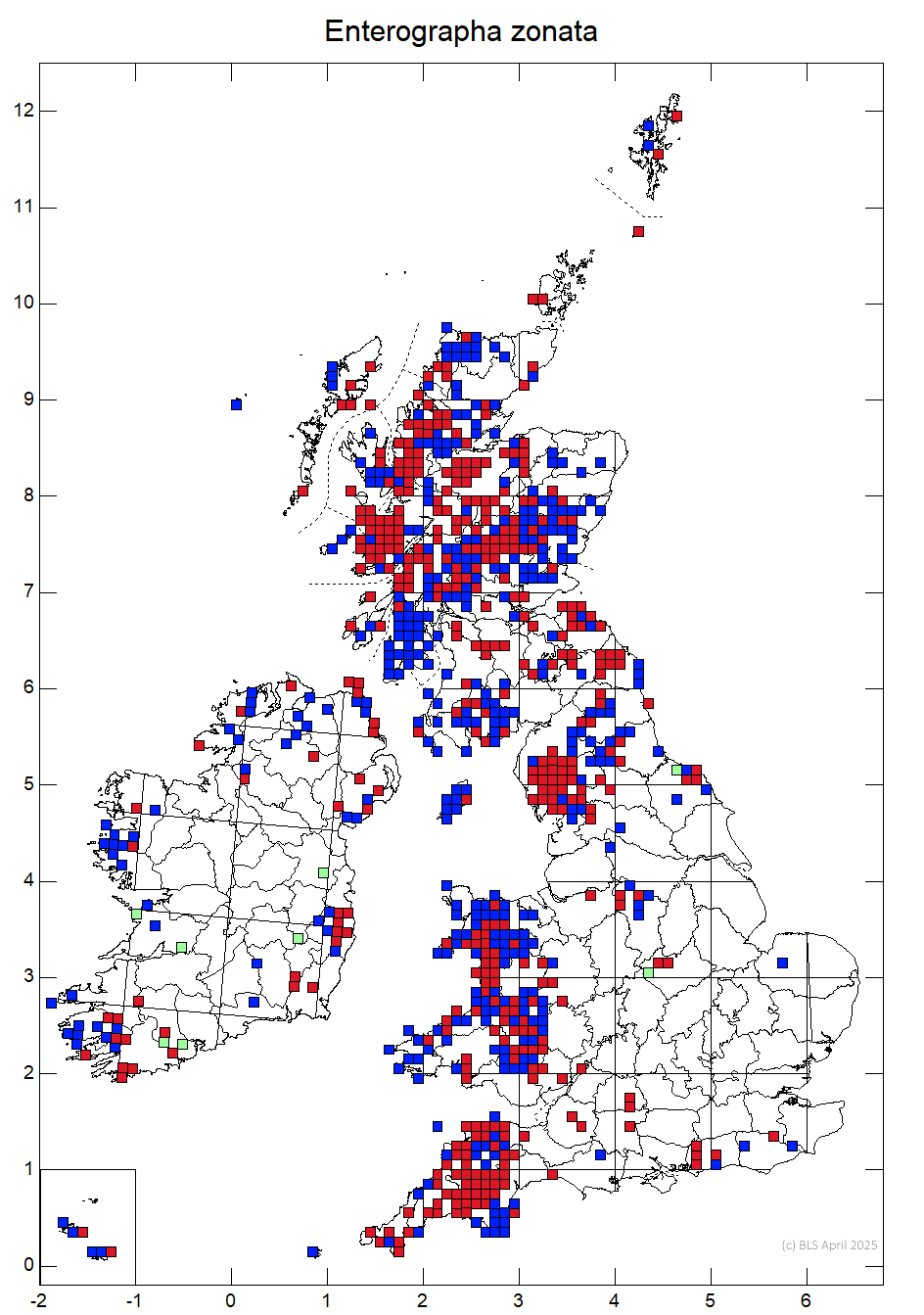A characteristic lichen of damp rock under overhangs in humid locations, where its dark chocolate-brown, thallus with paler punctiform soralia are easily recognised. Typically growing in mosaics with Gyrographa gyrocarpa (C+ red). Mainly an upland species but occurs rarely in the lowlands. Can occur on smooth bark on trees, where it may have been overlooked as Dendrographa decolorans but this lacks confluentic acid, so is K/UV–, while Enterographa zonata is K/UV+ mauve.
Thallus thin to rather thick, smooth, even or ± finely rimose-cracked, superficial, often delimited by a dark prothallus, often forming extensive mosaics, dark chocolate- brown, often tinged mauve; soralia (0.2–) 0.5–1 (–1.5) mm diam., C–, small, punctiform, rarely confluent, dark brown or ± to lilac-white, pale when abraded. Apothecia rather rare, 0.2–0.3 (–0.4) × 0.1–0.3 mm, 0.08–0.12 mm high, scattered, sessile, rounded or elliptical in surface view, unbranched; disc a slit; exciple K–; epithecium brown; hymenium 75–90 μm tall, I+ blue. Ascospores 24–28 (–32) × 3.5– 6 μm, 5- to 7(-11)-septate, with pointed ends. Conidia 5–6 × ca 0.5 μm, straight. Soralia C–, K–, K/UV+ mauve, KC–, Pd–, UV± deep blue (confluentic, 2′-O- methylmicrophyllinic and 2′-O-methylperlatolic acids).
Distinguished by the dark thallus with rounded, ± dark or lilac-mauve-white soralia and the thallus chemistry. Sequencing has shown E. zonata to be closely related to E. crassa (Ertz et al. 2009). Often associated with Gyrographa gyrocarpa (C+ red) and G. saxigena (no soralia). W. Britain, upland Ireland. Potentially overlooked on trees for the similar looking Dendrographa decolorans but this lacks confluentic acid, so is K/UV–
On deeply shaded siliceous rock overhangs in humid situations, rarely on shaded smooth deciduous bark, e.g. Beech and Holly.

Locally frequent in the uplands, rare in lowlands.
Cannon, P., Aptroot, A., Coppins, B., Ertz, D., Sanderson, N., Simkin, J. & Wolseley, P. (2021). Arthoniales: Roccellaceae, including the genera Cresponea, Dendrographa, Dirina, Enterographa, Gyrographa, Lecanactis, Pseudoschismatomma, Psoronactis, Roccella, Schismatomma and Syncesia. Revisions of British and Irish Lichens 16: 1-22.
Ertz, D., Miadlikowska, J., Lutzoni, F., Dessein, S., Raspe, O., Vigneron, N., Hofstetter, V. & Diederich, P. (2009). Towards a new classification of the Arthoniales (Ascomycota) based on a three-gene phylogeny focusing on the genus Opegrapha. Mycological Research 113: 141–152.
Text by Neil A. Sanderson based on Cannon et al (2021)
